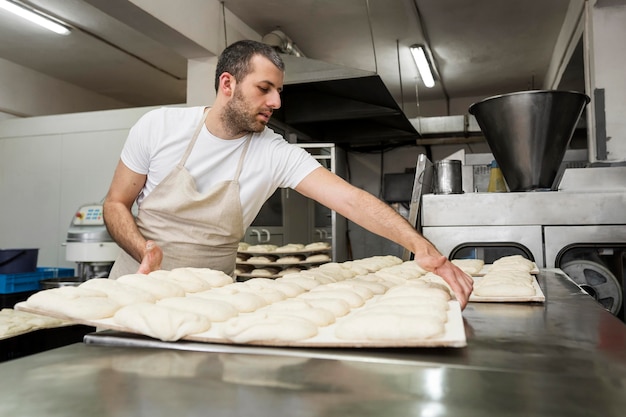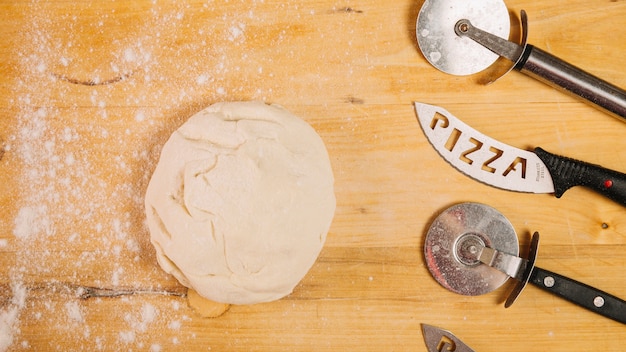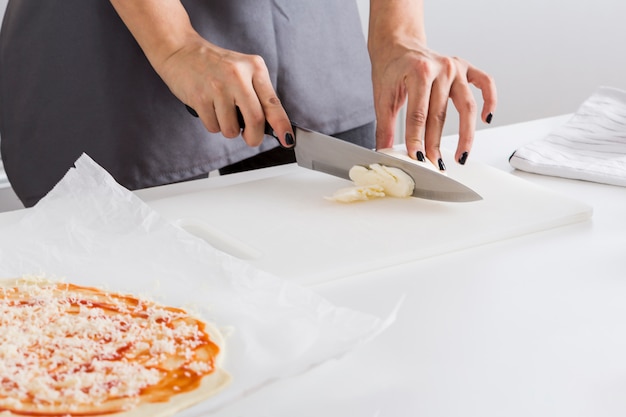(Part 1) Unveiling the Science Behind Pizza Dough Cooking

Before we start throwing dough in the oven, let's understand the science behind it. It's not just about heat and time, it's a delicate dance of ingredients and processes that come together to create that beautiful, edible masterpiece.
1. The Power of Gluten Development
You know those pizzas you see in Italy, with their perfectly stretchy crusts that seem to float in the air? That's the magic of gluten development. Gluten is a protein found in wheat flour, and when you mix it with water, it forms long strands that give dough its structure and elasticity. The more you knead the dough, the more gluten develops, creating that perfect chewiness and ability to hold its shape as it rises.
2. The Role of Heat and Yeast
Heat is the conductor in this culinary orchestra. It activates the yeast, that tiny little workhorse in our dough, causing it to ferment and produce carbon dioxide gas. This gas is what makes the dough rise, giving it that airy, light texture. But it's not just about rising, the heat also helps set the dough, creating that crispy crust we all love.
3. The Balancing Act: Moisture and Temperature
Imagine a tightrope walker, balancing precariously above a chasm. That's the relationship between moisture and temperature in pizza dough cooking. A wetter dough will take longer to cook through, requiring more time in the oven. Similarly, a hotter oven will cook the dough faster, potentially leading to a burnt crust if you're not careful. It's all about finding the sweet spot, the perfect balance to ensure a perfectly cooked pizza.
(Part 2) Setting the Stage: Preheating and Oven Types

Now that we've got the science down, let's get practical. Preheating your oven is like warming up your vocal cords before singing – it's essential for a successful pizza. It ensures the dough cooks evenly, resulting in that beautiful, golden-brown crust. Trust me, it's worth the extra few minutes!
1. Preheating: The Key to Even Cooking
Imagine dropping your dough into a cold oven. It's like asking it to perform a concert without a warm-up! The heat takes time to transfer to the dough, which can lead to uneven cooking, with the bottom getting burnt while the top remains doughy. Preheating your oven to the right temperature ensures that the heat is consistent, allowing the dough to cook evenly from the start.
2. Timing is Everything: Preheating Time
How long you need to preheat your oven depends on its type. For a traditional oven, 15-20 minutes is usually sufficient. But a pizza oven, which reaches much higher temperatures, needs 30-45 minutes to get those stones sizzling hot. It's this intense heat that gives us that wonderfully crispy crust in a matter of minutes.
3. Oven Types: Choosing Your Stage
Just like a performer chooses their stage, you need to consider the type of oven you're using, as it influences cooking time significantly.
- Traditional Oven: This is your everyday workhorse, the trusty companion for all your baking needs. It typically reaches around 250°C (482°F), which is perfect for a good, old-fashioned pizza.
- Pizza Oven: Designed for pizza perfection, these ovens crank up the heat to 400-500°C (752-932°F). This intense heat creates that crispy crust in a flash, often in just a few minutes.
- dutch oven: A heavy-bottomed pot with a lid, this versatile cookware creates an environment similar to a pizza oven. It traps heat and moisture, leading to a beautifully cooked pizza, with a slightly softer crust.
(Part 3) The Dough's Anatomy: Thickness and Size

Think of pizza dough like a canvas, and the thickness and size are your brushstrokes. They influence the cooking time, creating different textures and appearances. A thin crust pizza cooks much faster, while a large pizza needs more time to achieve that perfect doneness.
1. Thickness: The Canvas for Texture
The thickness of your dough is a personal preference. Thin crusts cook quickly, resulting in a crispy bite, while thick crusts offer a more substantial chewiness. A thinner crust is perfect for a crisp, quick pizza experience, while a thicker crust will require a longer cook time for that perfect chewiness and rise.
2. Size Matters: Scaling the Canvas
The size of your pizza dictates the distance the heat has to travel to cook the dough. A smaller pizza cooks quicker than a larger one. As a general rule, a 12-inch pizza takes about 10-15 minutes in a traditional oven, while a 16-inch pizza might need 20 minutes.
3. Dough Type: The Ingredient of Texture
The type of flour you use influences the texture of the dough, and hence, its cooking time. A traditional pizza dough, with a high gluten flour, creates a thick, resilient dough that takes longer to cook through. A thin-crust dough, often made with a lower gluten flour, cooks faster because it's thinner and less dense.
(Part 4) The Art of Doneness: Judging with Your Senses
This is where the real magic happens, my friends. Forget relying solely on a timer – it's about trusting your senses. It's an art form, a culinary dance where you listen to the whispers of the oven and observe the subtle changes in your pizza.
1. Visual Cues: The Golden Glow of Perfection
The first sign of a well-cooked pizza is its colour. The crust should be a beautiful golden brown, with a few char marks around the edges. This indicates that the dough has cooked through, achieving that perfect crispness we all crave.
2. The Smell Test: The Aroma of Success
Trust your nose, my friend! A freshly baked pizza has a distinct aroma, a symphony of toasted bread, melted cheese, and the intoxicating scent of your chosen toppings. If the aroma is subdued, your pizza might need a few more minutes in the oven.
3. The Touch Test: A Gentle Press for Doneness
Now, this one requires a bit of practice. Gently press on the centre of the pizza. If it springs back slightly, it's cooked through. If it remains indented, it needs more time in the oven. You want a crust that's firm but not hard, a balance between crispness and chewiness.
4. The Thermometer: A Scientific Approach
If you're unsure, you can always use a meat thermometer to gauge the internal temperature of the pizza. The ideal temperature is between 190-200°F (88-93°C). This ensures the dough is fully cooked without drying out and becoming brittle.
(Part 5) Navigating Variations: Finding Your Cooking Rhythm
Alright, now let's talk about those pesky variations in cooking time. There's no magic formula, my friend. It depends on the factors we've discussed: dough thickness, size, oven type, and even your personal preference. It's like finding your rhythm in a musical piece, adjusting the tempo as needed.
1. Observation: The Key to Mastering the Pace
The best way to determine the cooking time for your pizza is by observing it closely. Keep a watchful eye on your pizza as it cooks, looking for those subtle signs of doneness. Don't be afraid to peek in every few minutes to gauge its progress. It's better to be safe than sorry.
2. Time Ranges: A General Guide for Your Pizza Symphony
Here's a general guideline for estimated cooking times for different pizza sizes and oven types. Remember, these are just guides, and your oven and dough may require adjustments.
| Pizza Size | Traditional Oven (250°C) | Pizza Oven (400-500°C) |
|---|---|---|
| 12-inch | 10-15 minutes | 2-3 minutes |
| 14-inch | 12-18 minutes | 3-4 minutes |
| 16-inch | 15-20 minutes | 4-5 minutes |
3. Adjusting Cooking Time: Finding Your Tempo
If your pizza is cooking too quickly, lower the oven temperature. If it's taking too long, increase the temperature. It's a bit of a balancing act, but don't be afraid to experiment and find what works best for you and your oven.
(Part 6) Avoiding Common Pitfalls: A Guide to Success
We've all been there, haven't we? The pizza disaster, the burnt crust, the soggy centre, the toppings sliding off… It's enough to make you crave takeout. But fear not! I'm here to share some common mistakes to avoid and tips for success.
1. Overcrowding the Oven: Give Your Pizza Space to Breathe
One of the most common mistakes is overcrowding the oven. Too much in the oven at once, and the heat doesn't circulate properly, leading to uneven cooking. You'll end up with a soggy crust and unevenly cooked toppings. Give your pizza plenty of space to breathe, and it will reward you with even cooking and a beautiful crust.
2. Ignoring the Oven Temperature: Preheating is a Must
Another common mistake is not preheating the oven properly. We've already discussed the importance of preheating, but it's worth repeating. A cold oven means uneven cooking and a disappointing pizza. Preheating is your foundation for success.
3. Under-proofing the Dough: Let the Yeast Work Its Magic
If you're using a yeasted dough, proofing it properly before cooking is crucial. This allows the yeast to ferment, producing carbon dioxide, which gives the dough its rise and airy texture. Under-proofing results in a dense, chewy pizza. Give your dough the time it needs to rise, and it will reward you with a light, airy crust.
4. Not Rotating the Pizza: Ensuring Even Browning
Rotating your pizza during cooking is essential for even browning and cooking. Cooking only one side results in a burnt bottom and a pale top. Rotate your pizza halfway through the cooking time to ensure it cooks evenly, resulting in a beautifully browned crust.
5. Over-baking: Don't Burn Your Masterpiece
You don't want to overcook your pizza, my friend! Over-baking leads to a dry, brittle crust and burnt toppings. Keep a close eye on your pizza and pull it out of the oven when the crust is golden brown and the cheese is melted and bubbly. It's better to err on the side of under-baking than over-baking.
(Part 7) Troubleshooting Common Issues: Solving Pizza Puzzles
Okay, so you've followed all my advice, preheated your oven, checked for doneness, and avoided those common mistakes. But what if something's still not right? Fear not, my friends! I've got you covered! We'll troubleshoot some common pizza problems.
1. Soggy Crust: A Common Pizza Predicament
A soggy crust is a pizza tragedy! It's often caused by not preheating the oven properly or by using too much sauce and toppings. To prevent a soggy crust, make sure your oven is nice and hot, and be mindful of your toppings. You can also try cooking your pizza on a pizza stone or baking sheet, which helps absorb excess moisture.
2. Burnt Crust: A Sign of Over-baking
A burnt crust is another common pizza problem, and it's often the result of over-baking. If your crust starts to brown too quickly, lower the oven temperature or rotate your pizza more often. You can also try adding a few ice cubes to the bottom of the oven to create steam, which helps prevent the crust from burning.
3. Doughy Centre: A Sign of Under-baking
A doughy centre is frustrating, especially when you crave that perfectly cooked pizza. It's often caused by not cooking the pizza long enough or by using a dough that's too thick. To prevent a doughy centre, ensure your oven is hot and cook your pizza until the centre is cooked through. You can also try using a thinner crust or pre-baking the dough for a few minutes before adding the toppings.
4. Uneven Cooking: A Sign of Uneven Heat Distribution
If your pizza cooks unevenly, it's likely because the heat in your oven isn't circulating properly. You can try rotating your pizza more often or using a pizza stone, which helps to distribute heat more evenly. If you're still having trouble, you might need to adjust the rack position in your oven.
(Part 8) The Path to Mastery: Embrace the Journey
Listen, my friends, pizza dough cooking is a skill that takes time and practice. Don't be discouraged if your first few attempts aren't perfect. Just keep experimenting, learn from your mistakes, and enjoy the process. With patience and a bit of pizza love, you'll be a pizza-making master in no time.
1. Experimentation is Key: Discover Your Pizza Style
One of the best ways to learn is through experimentation. Try different dough recipes, oven temperatures, and toppings to see what you like best. The beauty of pizza is that there are endless possibilities, so have fun and get creative!
2. Don't Be Afraid to Ask for Help: Seek Guidance and Inspiration
If you're struggling with a particular aspect of pizza dough cooking, don't be afraid to ask for help. Talk to experienced bakers, check out online resources, or even take a pizza-making class. There's no shame in learning from others. We all started somewhere, and there's always something new to learn.
3. Enjoy the Process: Embrace the Pizza Love
Most importantly, enjoy the process! Making pizza is a fun and rewarding experience. Don't get too caught up in perfection. Relax, have fun, and enjoy the delicious results of your labour!
FAQs: Your Questions Answered
Let's face it, you've got questions, and I've got answers. Here are some frequently asked questions about pizza dough cooking.
1. How long should I proof my pizza dough?
The proofing time for pizza dough depends on the recipe and the temperature of your kitchen. Generally, it should take 1-2 hours at room temperature, or 4-8 hours in the refrigerator. The dough is ready when it has doubled in size. It's a patient process, but it's worth the wait for a delicious pizza.
2. Can I use store-bought pizza dough?
Absolutely! Store-bought pizza dough is a great option if you don't have the time or inclination to make your own. Just make sure to let it come to room temperature before you use it, as this will make it easier to work with.
3. How do I know if my pizza oven is hot enough?
A pizza oven is ready when it reaches a temperature of 400-500°C (752-932°F). You can check the temperature with a pizza oven thermometer, or you can simply sprinkle a few flour onto the oven stone. If the flour browns immediately, the oven is ready.
4. What's the best way to store leftover pizza?
Store leftover pizza in an airtight container in the refrigerator. You can also freeze it for up to 3 months. To reheat, bake it in a preheated oven until it's hot and the cheese is melted.
5. What are some tips for making a delicious pizza?
Here are a few tips to elevate your pizza game:
- Use high-quality ingredients. A good pizza starts with good ingredients. Think fresh, vibrant toppings that complement each other.
- Don't overcrowd the pizza with toppings. Less is more when it comes to toppings. Let the flavours of each topping shine through.
- Cook the pizza on a hot surface. Whether it's a pizza stone or a baking sheet, a hot surface ensures a crispy crust.
- Rotate the pizza halfway through cooking. This ensures even cooking and browning.
- Enjoy! Most importantly, enjoy the process and the delicious results.
Everyone is watching

Prime Rib Roast Cooking Time Chart: Per Pound Guide
Cooking TipsPrime rib roast. Just the name conjures images of lavish dinners, crackling fires, and hearty laughter. It’s ...

How Long to Bake Potatoes in the Oven (Perfect Every Time)
Cooking TipsBaked potatoes are a staple in my kitchen. They're incredibly versatile, delicious, and surprisingly easy to m...

Perfect Rice Every Time: The Ultimate Guide to Cooking Rice
Cooking TipsAs a self-proclaimed foodie, I've always been a bit obsessed with rice. It's the foundation of countless cuisi...

The Ultimate Guide to Cooking Asparagus: Tips, Techniques, and Recipes
Cooking TipsAsparagus. The mere mention of this spring delicacy conjures up images of vibrant green spears, crisp and burs...

Ultimate Guide to Cooking the Perfect Thanksgiving Turkey
Cooking TipsThanksgiving. Just the word conjures up images of overflowing tables laden with delicious food, the scent of r...
